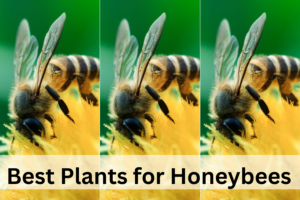Have you been wondering which plants are best for honeybees?
This post will give you some insight into the best plants for honeybees for beginners. There are many types of flowers that bees love to visit, however, some of the flowers mentioned in this post are the easiest to start growing for those who have never grown anything before.
Best Plants for Honeybees
-
Wild Flowers
Most wild flower seed mixes sold at the garden center or stores near your home will feed and attract honeybees to your garden. The seed packets usually contain a mix of flowers that are annuals which means that you will have to plant new seeds each year but they are usually inexpensive ranging from $1.00-$2.00. Wild flowers are some of the best plants for honeybees because of the diversity they offer pollinators who enjoy traveling back and forth to different flowers each day. Although not all native pollinators make honey, you will reap the three-fold benefit of pollinating your fruits and vegetables increasing crop yield (more food for you and your family), help support the endangered bee population (bees are now endangered because of toxic pesticides such as glyphosate) and feed honeybees that you may be raising as a bee keeper. There are many types of wild flower packets that can be purchased for all growing zones, usually the zone range for each packet will be on the back, most stores nearby will carry the flowers for your zone so you shouldn’t have to do too much research for this option. Wild flowers are low maintenance bee friendly plants that anyone can grow.
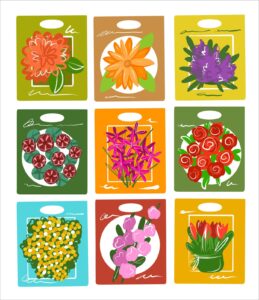
-
Bee Balm
Bee balm (Monarda) is also sometimes referred to as horsemint or bergamot and it is one of the best flowers for honeybees. There are many types of bee balm plants, some ranging from dark to light pink and some are even bluish. They are endemic to North America but can be grown anywhere that has a lot of sun and well-draining soil. This plant is also good for human consumption and has many health benefits so this particular flower is one that can benefit both the planter and the pollinator. These flowers bloom in the summer time and do best in full sun but partial shade is acceptable. They are perennials which means that they will continue to grow and bloom every year without the need to replant new seeds. Zones 3-9 are best for bee balm.
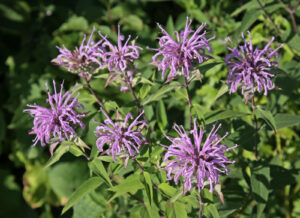
-
Purple Coneflower
Purple coneflower is known by many names such as echinacea, black sampson, scurvy root and comb flower. It is a low maintenance bee friendly plant that is beloved among honeybees. This plant is also mutually beneficial to the planter and pollinator as this plant is known for its medicinal value to people for centuries. Purple coneflower is one of the best plants for honeybees because you don’t need much effort in starting these plants from a seed and the bees love the nectar. Purple coneflower is a perennial that blooms in the summer; partial shade to full sunlight is best for these flowers. These are among the best plants for beekeeping. Zones 3-9 are best for purple coneflower.
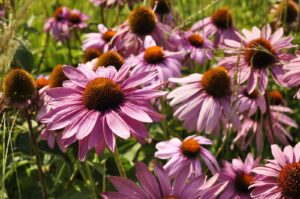
-
Goldenrod
Goldenrod is dainty and fluffy-looking but is quite hardy and resilient. You don’t need to water too often nor do you need to fertilize them. They thrive in sunny environments so planting in spring or fall is best in a sunny spot, partial shade is ok but be sure to plant them somewhere that gets at least 6 hours of sunlight a day. There are many varieties of goldenrod flowers but bees love them all. When your flowers grow to be a couple feet tall you can prune them to encourage them to grow bushier and develop more flowers rather than having a stalky plant. Goldenrod flowers are also one of the best plants for beekeeping. Zones 3-9 are best for goldenrod flowers.
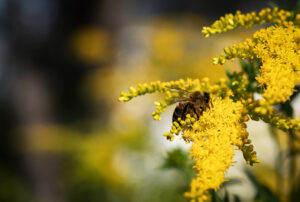
-
Aster
Aster is another favorite among pollinators but especially honeybees. These perennials are tall and bushy, measuring at about 3 feet in height and 18 inches wide at peak maturity. The flowers are almost like daisies but they require full sun to be at their best. This particular species of flowers tends to do better in moist soil so if you live somewhere with a lot of sand content in the natural soil you can easily purchase some gardening soil intended for the ground (different from potting soil) and mix it into the areas you want to grow your aster flowers. They require a cold winter to germinate and regrow each year so it would be best to plant in zones 3-8.
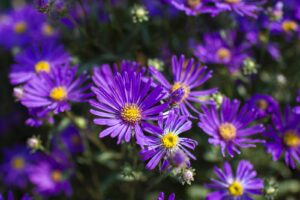
The best plants for honeybees are those that produce a good amount of nectar. This is not too hard to find when looking for flowers to plant. You can start with the flowers mentioned in this post or even try to plant various fruit trees. Fruit trees are a bit more work and require a little more expertise so starting with flowers is great for beginners but nothing is impossible for those who take the time to learn a new skill. Happy planting!
